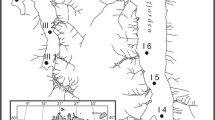Abstract
The littoral benthos of 18 lakes in Alberta and Saskatchewan ranging in salinity from 3 to 126‰ (g1−1 TDS) were investigated twice, in the spring and in the summer of 1986. Multiple Ekman dredge samples were taken at water depths of about 0.5, 1.0 and 2 metres in each transect. Two to three transects were used in each lake according to its estimated limnological diversity for a total of 114 stations. A total of 76 species was present varying from 29–31 species in the three lakes of lowest salinity (means of 3.1–5.55‰) to only 2 species in lakes exceeding 100‰. Species richness decreased rapidly in salinities greater than 15‰.
Biomass maximum mean of 10.91 g m−2 dry weight (maximum 63.0 g m−2) occurred in culturally eutrophic Humboldt Lake (3.1‰) but one third as great in other low salinity lakes. However, biomass again increased to about 4.5 gm−2 in two lakes of 15‰ As the salinity increased still further biomass declined steadily until a minimum of 0.0212 g m−2 was recorded in most saline Aroma Lake (mean 119‰). Summer biomass (11 lakes) was greater than spring biomass (4 lakes) because some groups such as amphipods, corixids and ostracods became more abundant in summer. Wet weight biomass averaged 15.8‰ of dry weight biomass.
Seasonality (spring or summer), sediment texture and organic matter content, water depth, pH, salinity (TDS) and the presence of aquatic plants (‰ plant cover) were considered in the matrix involving species dry weight biomass at each of 117 stations. TWINSPAN classification of the samples yielded a dendrogram with 18 indicator species. Successive dichotomies divided these indicator species into four main lake groups based on salinity, i.e., Group I: 3–10‰ (Gammarus, Glyptotendipes I, Chironomus cf. plumosus), Group II: 10–38%. (Hyalella, Enallagma,Bezzia), Group III: 38–63‰ (Hygrotus salinarius, Cricotopus ornatus), Group IV: >63‰ (Dolichopodidae, Ephydra hians). Each of these main groups was subdivided into smaller groups of lakes based on factors such as pH, seasonality (spring or summer species dominance), ‰ organic matter and ‰ plant cover. Depth of samples played no apparent role.
Similar content being viewed by others
References
Gauch, H. G., 1982. Multivariate Analysis in Community Ecology. Cambridge University Press, Cambridge, 298 pp.
Hammer, U. T., 1978. The saline lakes of Saskatchewan. III. Chemical characterization. Int. Revue ges. Hydrobiol. 63: 311–335.
Hammer, U. T., 1986. Saline Lake Ecosystems of the World. Junk, The Hague, 602 pp.
Hammer, U. T. & R. C. Haynes, 1978. The saline lakes of Saskatchewan. II. Locale, hydrogeography and other physical effects. Int. Revue ges. Hydrobiol. 63: 179–203.
Hammer, U. T., R. S. Haynes, J. M. Heseltine & S. Swanson, 1975. The saline lakes of Saskatchewan. Verh. int. Ver. Limnol. 19: 589–598.
Hammer, U. T. & J. M. Heseltine, 1988. Aquatic macrophytes in saline lakes of the Canadian prairies. Hydrobiologia 158: 101–116.
Hammer, U. T., J. Shamess & R. C. Haynes, 1983. The distribution and abundance of algae in saline lakes of Saskatchewan, Canada. Hydrobiologia 105: 1–26.
Haynes, R. C. & U. T. Hammer, 1978. The saline lakes of Saskatchewan. IV. Primary production by phytoplankton in selected saline ecosystems. Int. Revue ges. Hydrobiol. 63: 337–351.
Hill, M. O. 1979. TWINSPAN-A FORTRAN Program for Averaging Multivariate Data in an Ordered Two-Way Table by Classification of the Individuals and Attributes. Cornell University, Ithaca, 90 pp.
Last, W. M. & T. M. Schweyen, 1983. Sedimentology and geochemistry of saline lakes of the Great Plains. Hydrobiologia 105: 245–264.
Last, W. M. & T. H. Schweyen, 1985. Late Holocene history of Waldsea Lake, Saskatchewan, Canada. Quater. Res. 24: 219–234.
Parker, R. D. & U. T. Hammer, 1983. A study of the Chromatiaceae in a saline meromictic lake in Saskatchewan, Canada. Int. Revue ges. Hydrobiol. 68: 839–851.
Parker, R. D., J. R. Lawrence & U. T. Hammer, 1983. A comparison of phototrophic bacteria in two adjacent saline meromictic lakes. Hydrobiologia 105: 53–62.
Rawson, D. S. & J. E. Moore, 1944. The aline lakes of Saskatchewan. Can. J. Res., D. 22: 141–201.
Schweyen, T. & W. Last, 1983. Sedimentology and paleohydrology of Waldsea Lake, Saskatchewan. In M. D. Scott (ed.) Canadian Plains Proc. 11, Canadian Plains Research Center, Regina: 45–59.
Swanson, S. M. & U. T. Hammer, 1983. Production of Cricotopus ornatus (Meigen Dipera: Chironomidae) in Waldsea Lake, Saskatchewan. Hydrobiologia 105: 155–164.
Swift, M. C. & U. T. Hammer, 1979. Zooplankton production dynamics and Diaptomus production in Waldsea Lake, a saline meromictic lake in Saskatchewan. J. Fish. Res. Bd Can. 36: 1431–1438.
Timms, B. V., 1983. A study of benthic communities in some shallow saline lakes of western Victoria, Australia. Hydrobiologia 105: 165–178.
Timms, B. V., U. T. Hammer & J. W. Sheard, 1986. A study of benthic communities in some saline lakes in Saskatchewan and Alberta, Canada. Int. Revue ges. Hydrobiol. 71: 759–777.
Tones, P. I., 1976. Factors influencing selected littoral fauna in saline lakes in Saskatchewan. Ph. D. Thesis, University of Saskatchewan, Saskatoon. 185 pp.
Tones, P. I., 1978. Osmoregulation in adults and larvae of Hygrotus salinarius Wallis (Coleoptera: Dytiscidae). Comp. Biochem. Physiol. 60: 247–250.
Tones, P. I. 1983. Megalocypris ingens Delorme (Ostracoda) in Saskatchewan saline lakes: Osmoregulation and abundance. Hydrobiologia 105: 133–136.
Tones, P. I. & U. T Hammer, 1975. Osmoregulation in Trichocorixa verticalis interiores Sailer (Hemiptera: Corixidae) — an inhabitant of Saskatchewan saline lakes. Can. J. Zool. 53: 1207–1212.
Welch, P. S., 1948. Limnological methods. McGraw-Hill, Toronto. 381 p.
Wetzel, R. G., 1983. Limnology. 2nd Ed. W. B. Saunders Company Toronto. 767 p
Williams, W. D., 1964. A contribution to lake typology in Victoria, Australia. Verh. int. Ver. Limnol. 15: 158–163.
Winkler, D. W. (ed), 1977. An ecological study of Mono Lake, California. Inst. Ecology Publ. No. 12, University of California, Davis. 184 pp.
Author information
Authors and Affiliations
Rights and permissions
About this article
Cite this article
Hammer, U.T., Sheard, J.S. & Kranabetter, J. Distribution and abundance of littoral benthic fauna in Canadian prairie saline lakes. Hydrobiologia 197, 173–192 (1990). https://doi.org/10.1007/BF00026949
Issue Date:
DOI: https://doi.org/10.1007/BF00026949




